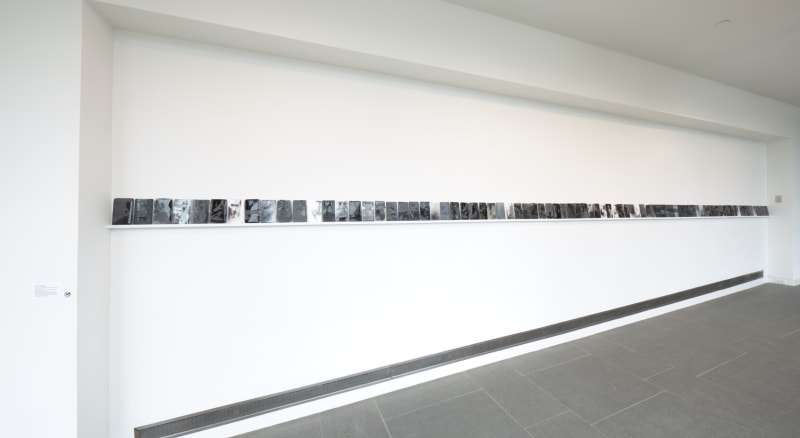BY LAURA HOFFMANN
EVERY TIME I plan a piece and, again, when I finish a piece I wonder if it needs to be in the world, and what might come after it, if anything. Does it need to take up space and time? I feel that the time that goes into something matters as much as the object itself. For this exhibition I spent time with the curator, Amy Smith-Stewart, deciding what to show and whether to indulge in a retrospective or to look at it more as a survey. Amy was adventurous enough to let me show not only my paintings, but also work that I’ve made out of glass, ceramic, and wallpaper.
The idea of a survey was engaging to me because I could not predict what Amy might respond to, from twenty-five years of my life. In the show you can see LA Uprising, 1994, for instance, which is a grid of broadsheets from the Los Angeles Times and the New York Times. I was looking at the gap then between experience and text, and how when reading a news story, for instance, you don’t know what physically happened. There’s so much more left out than what is there right in front of you. That’s why the materials are what they are: the Mylar magnifies what’s underneath it and also obliterates it, or removes it, because of the reflection.
As our technology has changed, I’ve adjusted how I read and absorb the things going on in the world. Runners Up comprises ninety-nine discrete glass objects—basically a collection of images of people running that one can hold in one’s hand. I made them with the assistance of glass artist Dorie Guthrie during a generous residency at Urban Glass. I’ve never worked with that material, but I wanted to present imagery in a way that was similar to how we encounter it on screens. In urban environments when we see people running, there are all these quick perceptions and assumptions that we make about what’s going on—who’s guilty, who’s innocent, what’s happened. I wanted to freeze those moments, not freeze them, not fix them with a photograph, but embed them in these layers of glass that both obscure and magnify what’s there. As you walk down the ramp next to Runners Up—I organized the piece for that wall because it faces a glass courtyard—you can’t see the imagery until you’re right on top of it due to the reflection
In some ways I might call this work “Almost”: nothing is ever arriving, no one ever gets anywhere, there’s no progress per se. It’s about fragmented movement, which I have looked at as subject matter in my paintings for years. It seems to me that in the twentieth century, physical movement has not only accelerated, but has become relevant subject matter in relationship to memory.
In the 1980s, when I first came to New York, works by Barbara Kruger and Jenny Holzer were on view a lot and were important to me. One reason their works were so powerful is that at that time they inserted themselves into the local New York world of macho expressive painting. I was interested in how you could take physical material and let it function in a way a voice would—as speech rather than disembodied text. I also like to isolate a single word, because that single word doesn’t tell you what to do. It doesn’t instruct you, it’s not a narrative, it’s not even creating an image necessarily. I didn’t want to name things either, which was the way in which Jean-Michel Basquiat, Julian Schnabel, and Cy Twombly positioned themselves with language. I wanted my paintings to be more about the combination of thought and feeling that I saw in Kruger’s and Holzer’s work. That’s how it started, and since then, there’s always been something to make a painting about.


